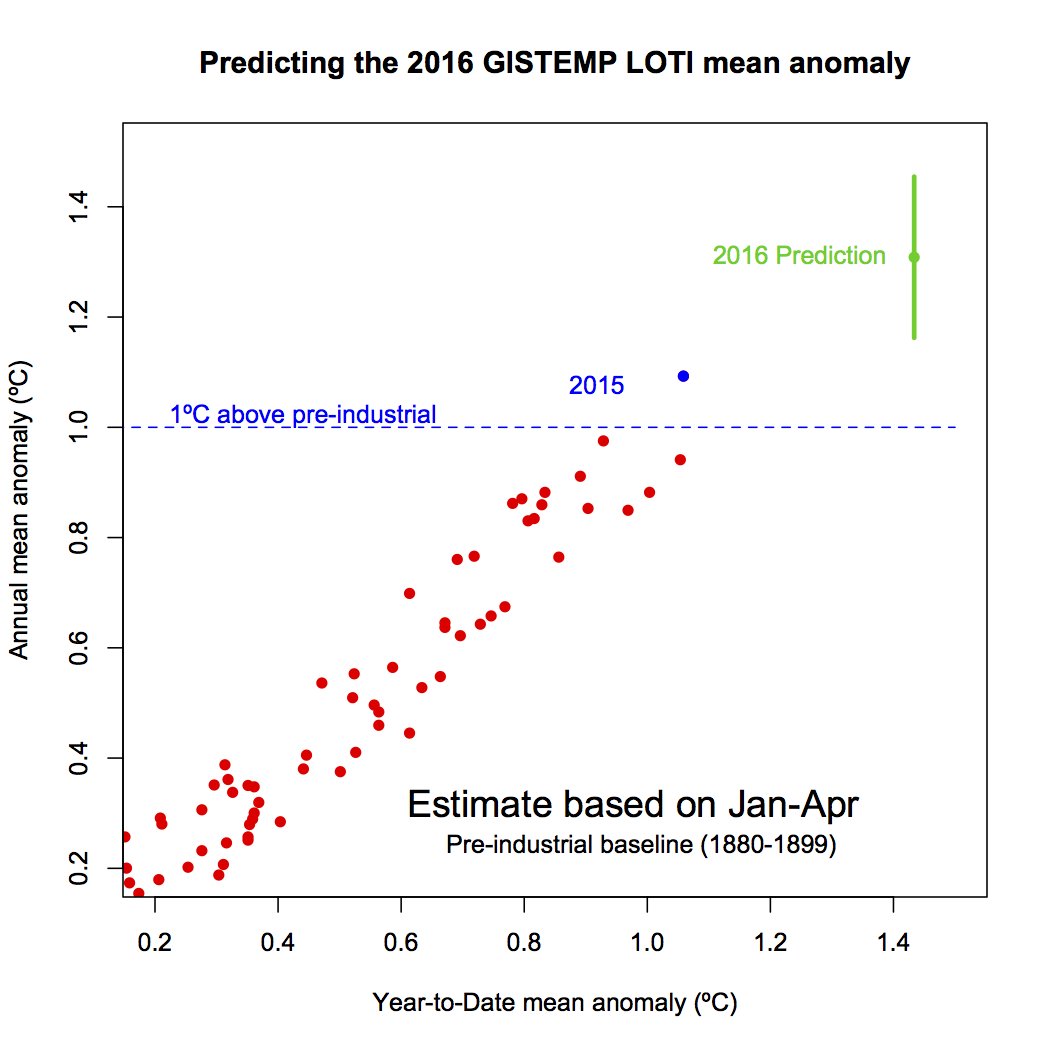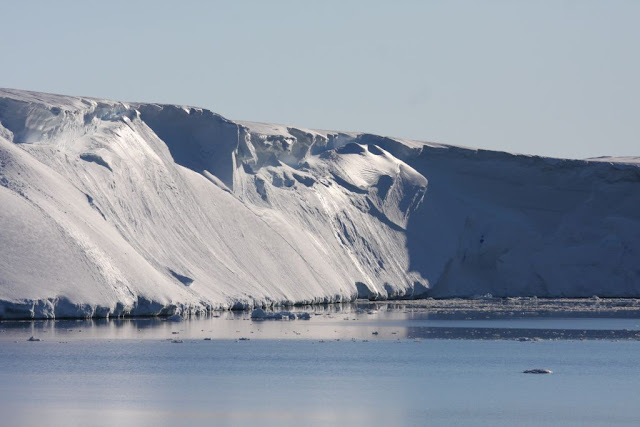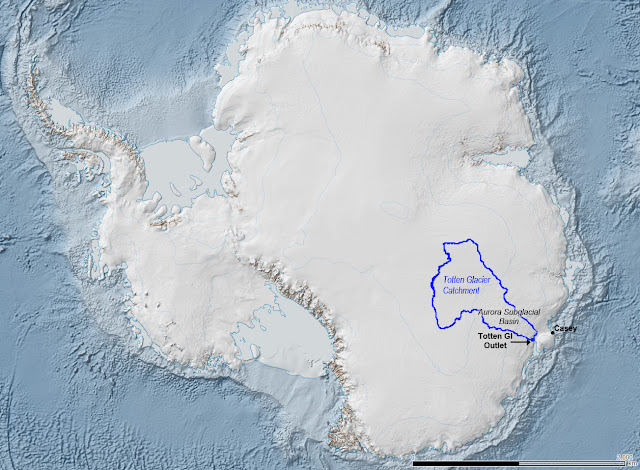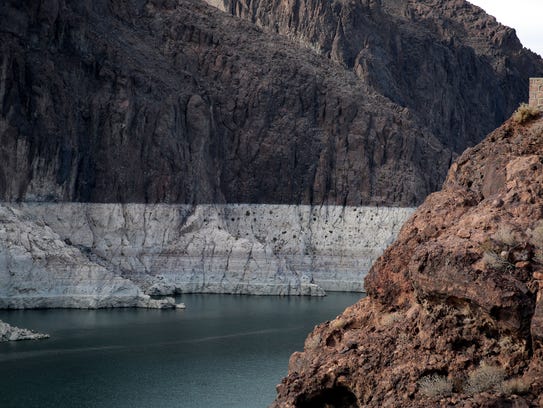Even for the fast-melting Arctic, 2016 is in ‘uncharted territory’One of the oldest and best-established ideas about global warming is that it will hit the Arctic the hardest. The concept, which goes back to papers published decades ago, is called “Arctic amplification,” and the basic idea is that there’s a key feedback in this system that makes everything worse.
It works like this: Warmer air melts more of the sea ice cover that sits atop the Arctic ocean, especially during summer, which is, of course, ice melt season. That means the ocean is able to absorb more solar radiation than before, when it was covered with ice that reflected this sunlight away. That means there’s more heat retained in the system — and so on, and so on.
So Arctic amplification has long been understood — and, confirming the theory, the Arctic has already been warming much faster than the more temperate latitudes. Even in this context, though, scientists have been noting that there seems to be something especially stark about what’s happening atop the world this year, which has seen overall temperatures soar to new highs.
“We’re in record breaking territory no matter how you look at it,” says Jennifer Francis, an Arctic specialist at Rutgers University who has published widely on how Arctic changes affect weather in the mid-latitudes. “The ice is really low, the temperatures are really high, the fire seasons have started earlier,” she says.
It’s an “uncharted territory situation that we’re finding ourselves in,” Francis says.
Indeed, NASA and other keepers of planetary temperatures have documented staggering warmth in the region this year — not just 1 or 2 degrees Celsius above average, but more than 4 degrees above average across much of the Arctic during the first quarter of this year:

January and February, in particular, set a new record for overall warmth in the Arctic, according to NOAA. Sure enough, when it comes to the U.S. Arctic in particular, Alaska has been warmer than ever recorded so far this year. NASA’s latest data show that this April was also record warm for the globe as a whole, but with some respite for some parts of the Arctic (though not others, including Alaska and Greenland).
And with temperatures already this warm, experts say we could see even more dramatic changes when summer arrives and we move fully into wildfire season, as well as the melt season for sea ice and the vast ice sheet of Greenland. Let’s look at some of these possible changes in sequence:
Sea ice. Arctic sea ice set a record in March for the lowest winter peak ever recorded. That means that during the time of year when there is seasonally the most ice covering the Arctic ocean, there was the least yet observed. More recently, Mashable’s Andrew Freedman highlighted fractures in the Arctic ocean ice cap between Greenland and the North Pole, which a leading sea ice expert, Mark Serreze of the National Snow and Ice Data Center, called “very unusual.”
All of which has raised concerns that 2016 may see a summer minimum for Arctic sea ice that is even lower than the all-time record year — 2012.
That isn’t assured yet — much could still change for the sea ice outlook. And scientists are struggling this year with the satellites they usually use to observe the Arctic, meaning the data are currently “provisional” (yes, at a critical time for climate change, we’re having technological problems observing it).
But nonetheless, the data, such as they are, suggest the extent of sea ice is running way below average now and also below levels seen at this time of year during the record low year of 2012:

Looking at temperatures and the extent of sea ice are surely the most obvious ways to take stock of what’s happening in the Arctic. But what’s striking is that if you talk to the experts on some of the other key Arctic systems, you hear pretty similar things.
Greenland. Take the enormous sheet of Arctic ice that, if we’re unlucky, will contribute to momentous sea level rise in coming decades and centuries. Greenland’s record melt year was also 2012, when the ice sheet is believed to have given up 562 billion tons of ice to the ocean, leading to well over a millimeter of global sea level rise in a single year.
Once again, we can’t be sure that 2016 will be like 2012 — much less that it will surpass it. Still, Greenland has already seen a startling early surface melt event — in April — which could set the stage for a great deal more as summer rolls around. “Every time you have these events, they do make changes to the properties of the snowpack that are all going in the same direction, which is basically accelerating the melting,” says Marco Tedesco, a Greenland expert based at the Lamont-Doherty Earth Observatory at Columbia University.
Tedesco says the critical factor will be the atmosphere — how much it carries warm, moist air over Greenland, as happened in 2012 when record melt occurred. Most recently, research has been homing in on how shrinking Arctic sea ice could be upending atmospheric patterns focused on the jet stream that could in turn entrain this warmer moist air and bring it north.
“There is this direct linkage, we think, between the sea ice loss and Greenland melt,” says Francis, who has recently published research on the topic. “So if we see a big ice loss melt this summer, most likely we’d see a big Greenland melt as well.”
Wildfires and permafrost. On land, meanwhile, the terrifying wildfire that devastated Fort McMurray, Canada, this year, while well south of the Arctic circle, has scientists wondering whether we could also be in for a very bad fire year in other parts of Canada, Alaska and Siberia.
Last year, Alaska saw its second-most extensive wildfire year ever. And this year, the weather is very warm. “Anchorage had its warmest April on record with a temperature of 43.5°F, 2.8°F warmer than the previous record set just last year,” the National Oceanic and Atmospheric Administration noted recently. “Parts of the Yukon River observed the earliest ice breakup on record, and Fairbanks observed a record-early ‘green up,’ or start of the vegetation growing season.”
“It certainly wouldn’t be surprising to me to have another one of these hugely anomalous years, where things dry out and burn,” says Max Holmes, a researcher at the Woods Hole Research Center who studies the interaction of wildfire and northern permafrost.
Holmes and his fellow Woods Hole expert Sue Natali will soon be traveling to the Yukon river delta region in Alaska, where there were intense fires last year, to see what it has done to the sensitive landscape. Fires consume trees and a thick organic layer at the forest floor and leave the remaining ground blackened. Sunlight then hits the dark, exposed surface and can quickly warm up the frozen soil layer beneath, dubbed permafrost. And that, in turn, can release carbon dioxide to the atmosphere, worsening warming.
While the researchers don’t know what they’ll find yet, they agree that 2016 is shaping up to be a momentous year. “It’s remarkable, this temperature anomaly for January, February, March, unbelievable,” says Natali.
Ted Schuur, a researcher at Northern Arizona State University who also studies permafrost and fire, concurs that we could be in for a great deal of northern burning this year. “This fire in Canada is the harbinger really of what could be a big fire season, depending on what happens with fire weather,” he says.
And he, too, fears not only fires but a hit to northern permafrost. “I’m really expecting this year, with the warm winter, especially low snow, to be another summer where we see permafrost thaw go even faster than it’s been going over the past five to eight years,” Schuur says. Based on preliminary data that he’s seeing at field sites, he says that the loss of carbon from permafrost is “happening several times faster even than our previous measurements have told us.”
So in sum: Scientists fear northern wildfires could be not only worsening, but also accelerating loss of permafrost from frozen northern and Arctic soils — which in turn would amplify global warming. And 2016, they think, could be a banner year for this process.
Granted, the atmosphere (and ocean) always deliver surprises, and as all of these researchers will tell you, there is no crystal ball to tell us what will happen in the Arctic as full summer nears. We only know that this year, five months in, is standing out for dramatic levels of warming, melting — and hints of early burning.











